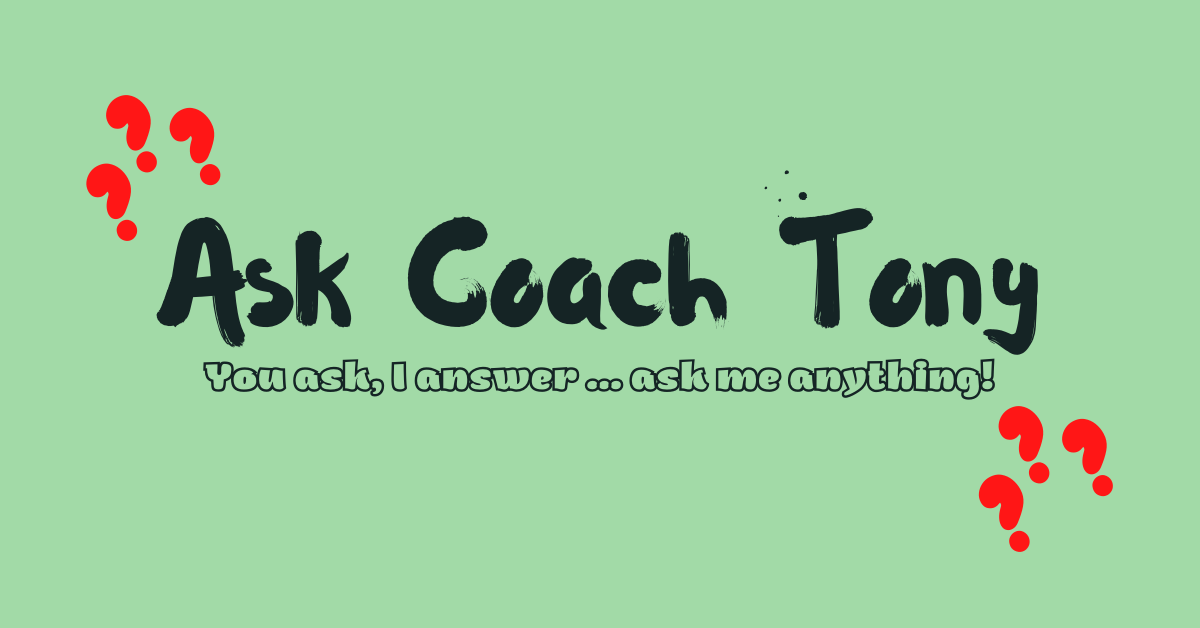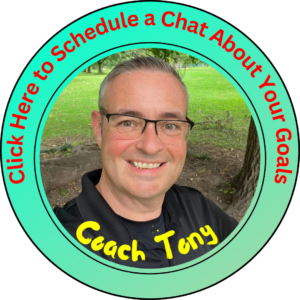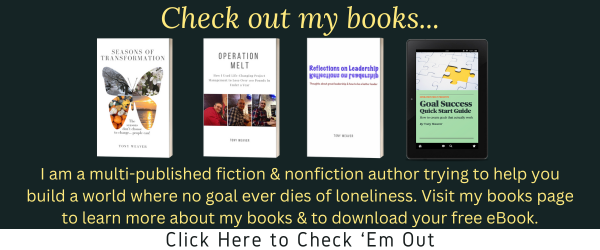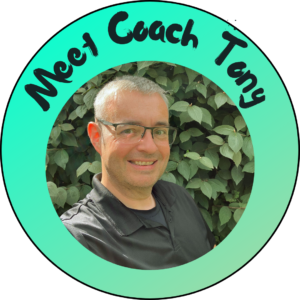In Ask Coach Tony, you can put my Operation Melt coaching to the test by asking me questions about how to achieve your goals. Go ahead, ask me anything!
Are you ready for a dad joke? I offer you this "dad joke" as a light "amuse-bouche" to entertain your mind before we get serious. My dad joke may be groan-worthy, but it's worth every penny you paid for it, right? A sole and a flounder are swimming in the ocean when they bump into each other. The sole says, "A flounder!" The flounder, to be polite, says nothing.
New Year, New You? Avoid These 3 Weight Loss Mistakes – Part 2
Week three of 2024 is over, as are more than 50% of the New Year’s resolutions people set just twenty days ago. Just a few days ago was an informal “holiday” known as “quitter’s day,” when most people will have given up on their resolutions, especially fitness-related ones.
“Quitters day?!” There is actually a holiday to celebrate giving up on goals! That’s terrible!

I shared last week (see New Year, New You? Avoid These 3 Weight Loss Mistakes) that the majority of resolutions people set are related to health, fitness and weight loss. This means millions of people give up on their health and return to the status quo before the year is even one-twelfth over.
To help reverse this trend of failure, I am dedicating my January Operation Melt blogs to examining the three biggest mistakes I have witnessed regarding weight loss. Even if you’re not trying to lose weight, these same three mistakes are also deadly for your other goals.
By avoiding these three big mistakes, you will be more likely to succeed with your weight loss or any other goal.
Weight Loss Mistake #2: Working THEIR Plan
There’s an old saying, “Plan your work, then work your plan.” As it applies to goals, this saying means you’ll need to create a plan to achieve your goal and then stick to it.
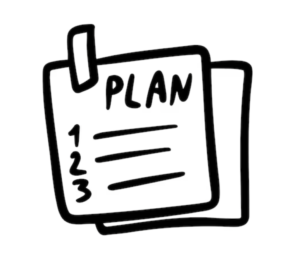
Pretty straightforward, right?
Maybe not.
When someone commits to losing weight, have you ever heard any of the following?
“That’s it, I’m totally going Keto!”
“That Adkins Diet seems to work well, I’m going to do that.”
“Time for me to go Whole 30.”
“I’m going to throw out all the junk food in my house.”
“I’m cutting down to 900 calories per day!”
“I’m never drinking again!” Ok, this one may not involve weight loss, just bad decisions.
It’s not just diets either; I hear all sorts of other bold claims, too.
“I’m going to start running.”
“I’ll just go to the gym every day.”
“I hear there’s a shot now.”
“I’m subscribing to this trainer’s weight loss program.”
“My friend bought a [insert trendy exercise equipment here] and lost a ton of weight, I’ll do that.”
“I know lots of people who do [insert trendy gym/sport here], and they all lost weight; I will, too.”
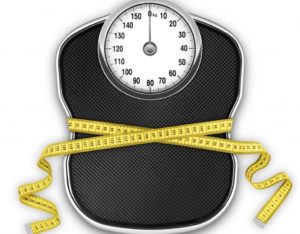
To be clear, I am not disparaging any of these weight loss strategies. Every one of them works for someone. But that doesn’t mean their plan will work for you.
The second biggest mistake people make when trying to lose weight is following a plan that doesn’t work for them. Your weight loss (and all your other goals) are very personal and require building a plan that works for you. Anything else is a recipe for failure.
This is why, when I coach people, I provide a structure and framework to set and achieve their goals but never a plan. You have to build your own plan. I can help you get there, but you are the one who has to do the work.
Wanna know a shortcut to goal failure? Follow someone else’s plan without considering whether it will work for you.
Working YOUR Plan
This may sound obvious, but there is no one-size-fits-all plan that works for everybody. Every person is different, with different habits, preferences, commitments and wiring. Working against your unique wiring significantly decreases your odds of success. However, finding ways to pursue your goals that are aligned with your unique personality can make you unstoppable.
As I explained in Operation Melt: How I Used Life-Changing Project Management to Lose Over 100 Pounds in Under a Year when I started my weight loss journey, I knew I had to set some boundaries when creating my plan.
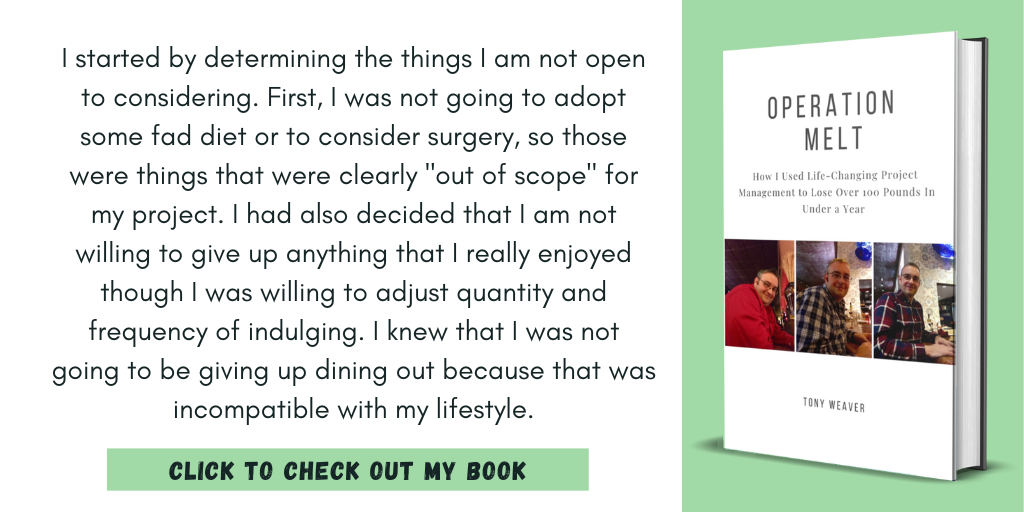
I recommend following a similar process when building your plan for your weight loss journey or other goal.
Step 1: What Is Your Goal?
Start your planning process by writing down your goal, but make sure it’s a SMART goal. If you haven’t created your goal yet, my free Goal Success Quick Start Guide eBook will walk you through the process.
Once you have defined your goal, I suggest using my Project Charter Worksheet (available as a free download in the Operation Melt Resources section) to “formally” capture and commit to your goal. This worksheet includes writing your goal, your why, some immediate reinforcement actions, and other quick start actions to start building some momentum.
Step 2: What Are Your Boundaries
After committing to your goal, it’s time to decide the boundaries that will guide your journey: what things you WILL do and want things you WON’T consider.
Not sure where to start? You may want to start with a bit of research about weight loss strategies. Usually, weight loss is achieved by adjusting your energy balance to burn more calories than you consume. This means increasing your burn (exercise) and decreasing your consumption (diet). How you do this is where your boundaries come into play.
Divide a blank sheet of paper into two columns labeled “Wills” and “Won’ts.” Then, start writing. Capture everything you can think of that you are and are not willing to do. Once you have a complete list, review what you wrote and do a little editing. Include the most critical few items in each column – the number is up to you, but simpler is usually better.
Here is an example of my wills and won’ts from my weight loss journey:
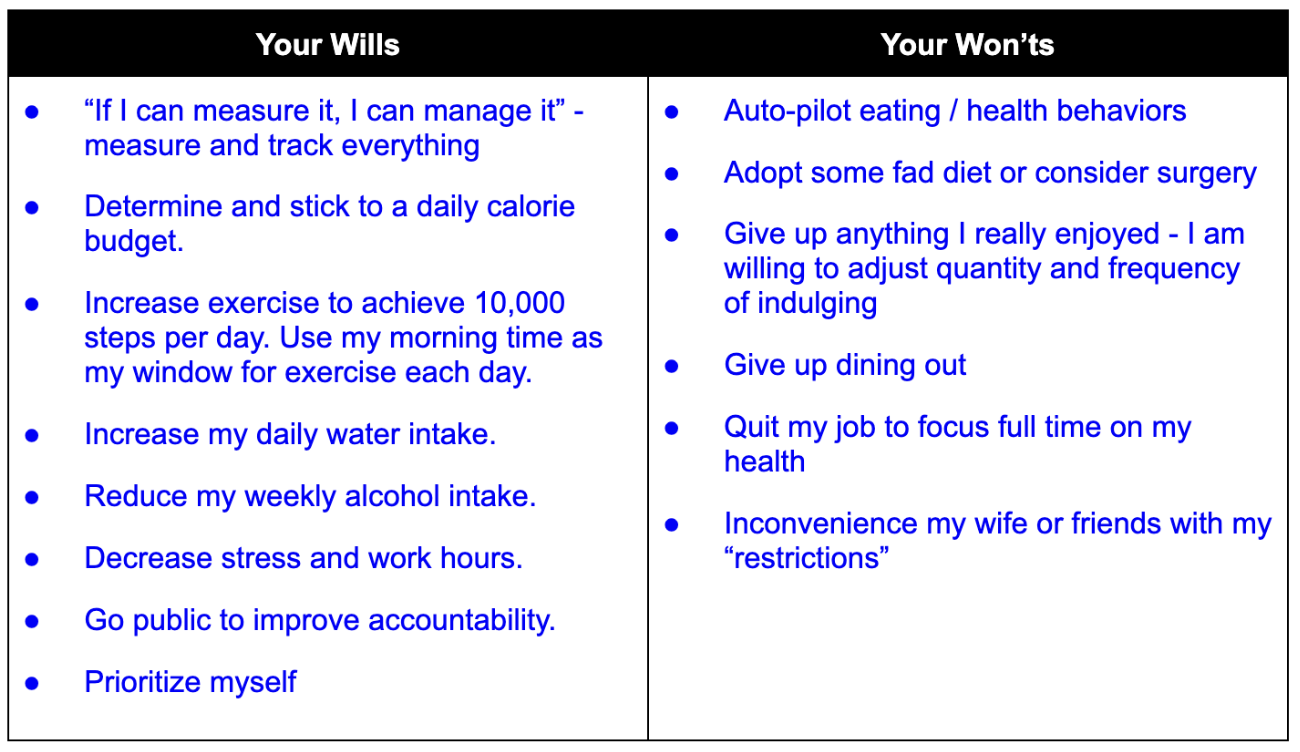
Step 3: What Are Your Milestones
When you have decided on your SMART goal and the behaviors you will adopt to get there, the next step is to identify your milestones. Milestones mark specific points along a project timeline. You can use these milestones to measure whether or not you are on track with your goal.
More importantly, you can use your milestones to plan celebrations at specific times in your journey. Do you want to celebrate your first five or ten pounds lost? Do you want to celebrate your halfway point? Do you want to celebrate the completion of your first 5k race? These are all points on your timeline.
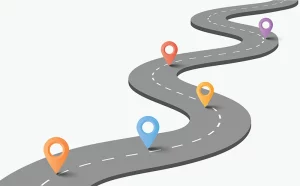
The easiest way to define milestones is with math. How many pounds do you plan to lose? How many months away do you plan to have lost the weight? With those two pieces of data, you can plot out where you want your weight loss total to be at the end of each month. Then, you can add any other planned celebration points.
And, just like that, you have a plan that includes your goal, the actions you plan to take, and a detailed timeline. It feels good, right? Good! High-five yourself; you’ve earned it.
But let’s also take one last step to build the plan that works for you… let’s think about problems.
Step 4: Risks
No plan will ever go exactly as expected. That’s why a big part of my Project Manage Your Life process is to expect and plan ahead for problems. These things that might go wrong are called risks. The secret to managing risks is identifying them early and planning your response (or mitigation) strategies.

Looking at your goal, wills and won’ts, and milestones, spend a few minutes brainstorming all the things that might go wrong. Where might you face setbacks? I suspect this brainstorming process will go pretty quickly because our brains are trained to look for problems.
Once you have a list, select the 3-4 items that are the highest priority. Your priority items are those with a high probability of occurring or items with a moderate probability and the most impact if they do happen. These are the risks that you will want to actively manage.
For each high-priority risk, sketch out some ideas of things you can do to reduce the probability of them happening. Then, think about how you will respond if each item does happen. Planning ahead will save you from panic later, should these items pop up.
And…. Go!
Congratulations, you have a plan! Great work!
The time has come to get moving and start following your plan to the finish line. Write out a ta-da list for the next two weeks – the items you will celebrate having achieved two weeks from now. Once you have those two-week goals, get out there and crush them… then celebrate them!

Just remember President Eisenhower’s words, “Plans are nothing; planning is everything.” The plan you create today will not be the same when you cross the finish line. You will learn a lot along the way, and your plan will evolve.
Two weeks from now, as you celebrate your ta-da list achievements, also spend a few minutes reviewing your plan and editing it as needed.
Once you’ve finished your ta-da list celebration and your review of your plan, repeat this two-week cycle until you reach the finish line. Then celebrate even bigger because you have conquered two killer weight loss mistakes.
It’s time to crush your goals… two weeks at a time!
The process I just shared for building your plan is the same process I use with my coaching clients. Would you like a little one-on-one assistance with finalizing your goal and plan? I am a Master Life Coach, and I am at your service. You don’t have to do it alone.
I believe in you and want to help YOU believe in you!
Meet Coach Tony
My name is Coach Tony, and I am a coach, author and project manager on a mission. I am working to build a world where no goal ever dies of loneliness.
I almost allowed one of my biggest life goals to die without ever being attempted for forty years. My goal almost died, not of failure but of loneliness. But, I took a risk and leveraged a simple, logical process that helped me wildly exceed my goal.
I transformed my life, and you can do the same with the help of Operation Melt.
Operation Melt provides engaging, practical content and hands-on coaching to inspire, motivate and equip project managers and other left-brained high-achievers to pursue and accomplish their biggest goals.
Breathe new life into your goals
Download my free ebook to learn how to create goals that actually work and get the jump-start you need in life!
